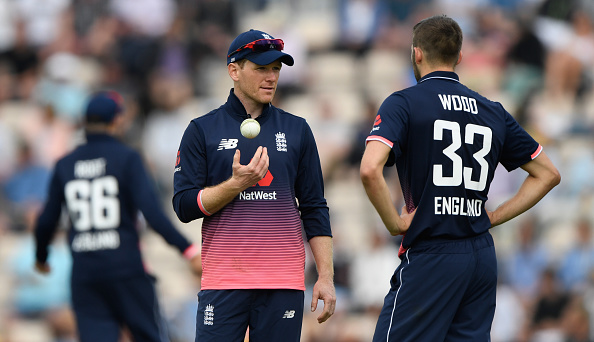South Africa, chasing 331 to win the second Royal London ODI against England at the Ageas Bowl and square the series with one match to play, are 305-5 needing 26 runs from the remaining 13 balls of a nip-and-tucker with two batsmen well set and five wickets standing.
Mark Wood sends down a length ball, Chris Morris swings and smashes it over long-on for six. Twenty runs needed from 12 balls: Jake Ball bowls another bang in the slot which the left-handed David Miller now launches back over his head and over the ropes.
Fourteen runs needed from 11 balls: Ball, attempting to compensate, gets his length, pace and angle horribly wrong and Miller whacks a wide long-hop to the backward point boundary, leaving 10 runs to be scored from 10 deliveries by two men seeing it like a watermelon.
Miller pulls the third delivery of the 49th over for a single, Morris hooks the fourth to long leg for another. With eight needed from eight, the batsmen are riding a winning momentum and Ball and his skipper Eoin Morgan are racking their brains for a way, an idea, anything to knock them out of their stride.
And then it happens.
Ball sends an off-cutter into the pads of Miller and the batsmen scamper through for another single.
Clearly, as he has delivered it from round the wicket and, after pitching well short of a length outside off-stump, it has hit the batsman’s pads in line with the leg stump, the bowler’s appeal is merely for show and umpire Chris Gaffaney turns it down without a second glance.
It almost goes without saying that everyone concerned knows that. Were Morgan to ask for a DRS review, there would be no chance of the third umpire Rod Tucker overturning the onfield decision of not out and Ball actually advises his skipper against doing so.
But when Morgan decides to call for one anyway, former England captain Nasser Hussain, commentating on Sky TV, calls it straight away: “Tactical review… around the wicket… don’t think this has a lot going for it…”
Tactical review. Two words that once again highlight the growing conviction among many that whatever technology is available to umpires on and off the field should be left in the hands of the umpires alone to use as and when they see fit, for the only good reason any of it should be utilised at all, namely, to make sure, wherever possible, the correct decision is made.
Morgan is utterly blameless in all this. In fact, he deserves nothing but credit for displaying coolness under pressure and for the courage to take the risk of wasting a review now when it might have come in handy later, presumably on the basis that there might not be a later.
And if it was his intention that the delay should allow his players to take a moment to refocus and for the batsmen to be held up for a few seconds to stew and wait when all they wanted was to keep going, it certainly worked.
Wood’s brilliant final over, restricting South Africa to just four runs when only seven were needed, would have been good enough to win the tightest of tight matches anyway and South Africa’s highly experienced batters should have had enough about them to make sure they were not distracted by anything other than see-ball, hit-ball and tip-and-run in those closing moments.
Indeed, the words of their captain after the match were not of complaint, but of respect.
“The fact that they won,” commented AB de Villiers, “now maybe you can say, ‘great captaincy, Morgs: Maybe it was just to slow the game down as well as the review’.”
The fact is that any of Morgan and AB’s contemporaries would have been more than happy to have pulled the same stroke and would have been similarly praised for doing so.
Yet, no matter how deftly he employed it, none of that alters the fact that Morgan’s actions in bending the DRS to his will as a purely tactical tool actually constitute an abuse of what the system was designed for in the first place, which, lest we forget, was to help umpires avoid making howlingly bad decisions.
For while the technology to improve decision-making has come on with snickos and ultra-edges since its inception and the pace and smoothness of those calls being communicated has speeded up exponentially, those advances have merely magnified the obvious shortcomings.
Leaving aside the contentious issue of “umpire’s call” on lbws, which even ICC have finally recognised must be amended so as not to punish the fielding side when the ball would actually have hit the stump, most of those come under the heading of “tactical use”.
To name but a couple; a batsman being given out (or not out) incorrectly simply because his side has run out of reviews (how many times has a tail-end Charlie been erroneously dismissed because a proper batsman has used up a review on the off-chance that he might get away with one?) or a skipper taking into account the efficiency of the technology to prove or disprove a particular case.
There is one obvious solution to all this, of course. For once you have committed yourself to the idea that the technology should be used to ensure, as near as possible, 100 per cent correct decisions, logic demands it should be used 100 per cent of the time, by the umpires off their own bat and not when prompted by the players.
Even those who have driven the DRS onward, whatever the rest have wanted, appear too squeamish to go so far as that logic would have us travel, in effect every single decision for every single appeal being referred by onfield umpires to their colleague in the TV studio as automatically as those for run-outs and stumpings already are.
David ‘Bumble’ Lloyd’s answer to the reason why that should not happen is simple: matches would last twice as long as they do now.
Yet, judging by the pace at which the game is being transformed into a techie wonderland, the process may already be irreversible and the outcome merely a matter of time.
Review, anyone?
This piece originally featured in The Cricket Paper, June 2 2017
Subscribe to the digital edition of The Cricket Paper here












